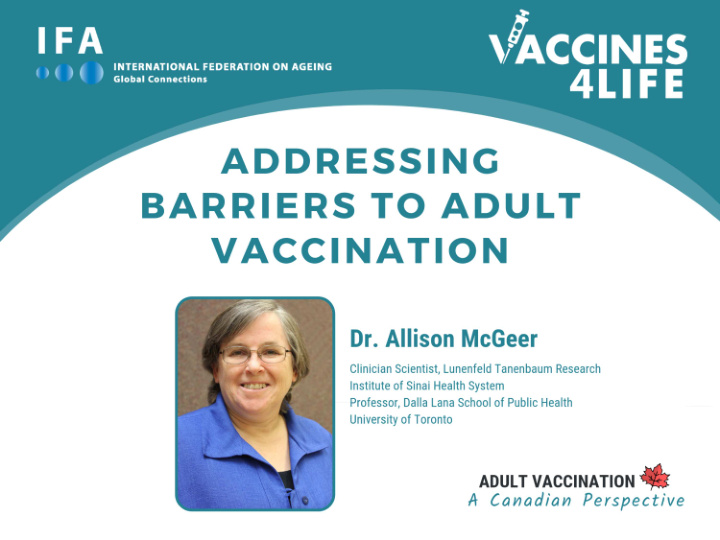



Addressing Barriers to Adult Vaccination: A Canadian Perspective Allison McGeer, MSc, MD, FRCPC, FSHEA, FAMMI Sinai Health System, University of Toronto
Necessary components Effective vaccination programs • Evidence of (and belief in) burden of disease • Evidence for (and belief in) effectiveness of vaccine • Advocacy • Public health, healthcare providers, patients • Effective delivery system • Assessment of performance • Accountability 3
Burden of disease - evidence • Many adult vaccines prevent infections where etiology is difficult to diagnose • E.g. many microbes cause pneumonia • Good evidence for burden 4
Vaccine effectiveness Evidence • Challenges with evidence • Prevention of non-specific versus specific outcomes • e.g. influenza versus influenza-like-illness; pneumococcal pneumonia versus all pneumonia • Variability year to year in influenza vaccine effectiveness • Uncertainties about duration of protection with new vaccines • Nonetheless • Good evidence that recommended vaccines are a benefit to adults 5
Vaccine/group Percent vaccinated Influenza vaccine, 65+ 67% Influenza vaccine, adult 18-64 years with 44% chronic conditions Influenza vaccine, pregnant women 10% Pneumonia vaccine, 65+ 37% Pneumonia vaccine, adults 18-64 years with 17% chronic condition Hepatitis B vaccine, adults with liver or kidney 45% disease HPV vaccine, women 16-24 years 45% Pertussis vaccine, pregnant women 8%
Burden of disease Belief • We are frightened by things that: • Are new, unusual or foreign • Have a high case fatality • Meningitis: 95 cases; 15 deaths (1 in 8 people die) • Influenza: 350,000 cases; 2500 deaths (1 in 7000 people die) • It is easier to believe in things we can identify 7
Vaccine effectiveness Belief • Challenge • Perception that vaccines need to be 100% (or nearly 100%) effective 8
“_____________ doesn’t work well enough to warrant me getting vaccinated/recommending vaccination to my patients” • Statins reduce your risk of a heart attack, or of dying from coronary artery disease by 28% • Lowering blood pressure reduces risk of MI by 20%-25%, and of stroke by 35%-40% • Blood thinners for atrial fibrillation reduce the risk of stroke by 50-60% • Bisphosphonates reduce the risk of osteoporotic hip fractures by 40-50%
Vaccine effectiveness Belief • Challenge • Perception that vaccines need to be 100% (or nearly 100%) effective • Getting past the double standard • Re-framing in communication and education 10
Advocacy • Prevention is always a hard sell • Success is invisible, non-dramatic, not personal • Rewards are delayed • Benefits to not accrue to the payer • Healthcare providers prefer to make sins of omission rather than sins of commission • Thus • Strong, vocal, persistent advocates for prevention are always essential 11
Effective delivery system • Simple • Clear • Reliable • Stable • Well-known • Minimal resources (time, money, though) required from all participants • Vaccine delivery staff • Health care providers • General population 12
Ontario pediatric immunization schedule 13
Adult vaccination Zoster vaccine • Canadian recommendation • RZV for adults 50 years of age and over • RZV may be considered for immunocompromised adults ≥50 years of age based on a case-by-case assessment of the benefits vs risks. • Ontario • LZV recommended for adults over the age of 65 years • LZV provided free (supply in family physician office) for adults aged 65-70 years 14
Adult vaccination Influenza vaccine, 2018/19 • Influenza vaccine supplied in family physician offices and by pharmacies • High-dose influenza vaccine recommended for older adults • Pharmacies not permitted to administer high-dose vaccine 15
Creating an effective system • Paying for vaccines • Mitigating public health budget impact • Removing the double standard compared to drugs • Creating guidance for decision making • System design – requires: • A deliberate plan, assignment of resources, continuous assessment of progress and revision • Scoping for what changes are already happening • E.g. moving away from annual physical exams to periodic preventive health visits • Careful thought about the full range of possibilities 16
Assessment of performance Accountability 17
Percentage of Canadian adults up-to-date with vaccines, 2013-18 Vaccine/group Percent vaccinated Influenza vaccine, 65+ 71% Influenza vaccine, adult 18-64 years with chronic 39% conditions Influenza vaccine, pregnant women 10% Pneumonia vaccine, 65+ 37% Pneumonia vaccine, adults 18-64 years with 17% chronic condition Hepatitis B vaccine, adults with liver or kidney 45% disease HPV vaccine, women 16-24 years 45% Pertussis vaccine, pregnant women 8% Herpes zoster vaccine, 65+ ??
What about the short term? • Individuals • Talk about vaccines; amplify public health messages • Remind your family, friends to get vaccinated • Health care providers: 19
Ottawa family health team Improving access to vaccines • EMR searches for patients missing vaccination • Notification of patients by phone/email • Vaccination reminders present in charts • Vaccination reviewed at every patient visit • Stocking of some vaccines for patient purchase • Providing information and DIN numbers, so patients can find out if their insurance covers particular vaccines • Promotion • posters and pamphlets in waiting room; information on website • social media posts • Medical directive for patients with vaccine prescription • Storage of second dose 20
21
Question and Answer Period Please use the Q&A feature at the bottom of your screen.
Pre-Conference Summit | 31 October 2020 Informing the global agenda for a life course approach to adult vaccination through a one-day Vaccines4Life Summit with a focus on: • Understanding the public impact of vaccine preventable diseases • Inspiring change through examples of good practice from around the world • Galvanising action through targeted communication strategies
Recommend
More recommend